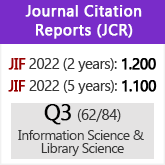Analysis and evaluation of the national libraries websites: case study of the National Libraries of Brazil and Portugal
DOI:
https://doi.org/10.3989/redc.2007.v30.i2.379Keywords:
national libraries, Lusophone national libraries, website, analysis, evaluation, Portugal, BrazilAbstract
TICs facilitate the compilation, preservation and diffusion of the information in digital format. The national library, as other patrimonial institutions, have made the necessary adaptations to integrate the digital world in order to do this mission. So, the national library website must perseve the digital national information must respect some formal, informative and ergonomic conditions in order to its Web access. In this paper we aim to investigate the use of web sites phenomenon. The work comprises an approach to the website of National Libraries of Brazil and Portugal in order to analyse and evaluate them with some established indicators. The results obtained show strengths and weaknesses related to the quality of the webs in discussion, and pretend to be applicable to National Libraries Website and serve as a reference for present experiences and future developments.
Downloads
References
Baeza Yates, R. (2004). Arquitectura de la información y Usabilidad en la Web [en línea].
Barboza, E. Ma.; Nunes, E. M.; Sena, N. (2000). N. Web sites gobernamentais, uma espalanda à parte. Ciência da Informação, 29 (1), 118-125. doi:10.1590/S0100-19652000000100012
Bozena, M. (2002). The evaluation of the quality of web-based library information services. Quality in libraries. Part two. EBIB, 2, [en línea].
Buenadicha, M.; Chamorro Mera, A.; Miranda, F. J.; Gonzalez López, O. A new Web assessment index: Spanish universities analysis. Internet Research, 11, (3), 226-234 [en línea].
Carrión Gútiez, M. (1995). Manual de bibliotecas (2.ª ed.) Madrid; Fundación Germán Sánchez Ruipérez; Pirámide, p. 37.
Clausen, H. (1999). Evaluation of library Web sites: The Danish case. The Electronic Library, 17 (2), [en línea].
Codina Bonilla, L. (2005). La página Web. En: Luisa Orera Orera (ed.). La Biblioteca Universitaria: Análisis en su entorno híbrido. Madrid, Síntesis, 379-381.
Hassan Montero, Y. (2006). Factores del diseño Web orientado a la satisfacción y no frustración de uso. Revista Española de Documentación Científica, 29 (2), 239-257. doi:10.3989/redc.2006.v29.i2.291
Herrera Morillas, J. L. (2001). Presentación y organización de la información en los sitios Web de las bibliotecas universitarias españolas. En: La organización y representación del conocimiento: metodologías, modelos y aplicaciones: Actas del IV Congreso ISKO-España, 25-27 abril, Alcalá de Henares, Madrid.
Jasek, C. (2004). How to de sign Library Web site to maximize usability. San Diego, C.A.; Library Connect; Elsevier User Centered Design Group. [en línea]. Disponible en http://www.elsevier.com/framework_librarians/LibraryConnect/lcpamphlet5.pdf [consulta: 15 de enero de 2007].
Kelly B.; Peacock, I. (1999). Web Watching UK Web Communities: Final Report for the Web Watch. Proyect. British Library Research Innovation Centre. Disponible en: http://www.ukoln.ac.uk/web-focus/webwatch/reports/final/rtf-html/frames/report.html [consulta: 01 de febrero de 2007].
Line, M. (1989). The role of national libraries and information needs: alternative means of fulfilment with special reference to the role of national libraries. Paris: UNESCO, p. 11- 12.
Marcos, M. C. (2001). HCI (human computer interaction): concepto y desarrollo. El profesional de la Información, 10 (6), 4-16. doi:10.1076/epri.10.6.4.8200
Marcos, M. C.; Rovira, C. (2006). Las webs parlamentarias: funciones y elementos de su interfaz en el acceso a la información. Revista Española de Documentación Científica, 29 (1), 13-35. doi:10.3989/redc.2006.v29.i1.285
Mcgillis, L.; Elaine, G. T. (2001). Usability of the Academic Library Web Site: Implications for Design [en línea].
Olsina, L.; Goody, D.; Lafuente, G. J.; Rossi, G. (1999). Specifying quality characteristics and attributes for websites, I ICSE Workshop on Web Engineering. Los Angeles, USA.
Pisanski, J.; Maja, Z. National library websites in Europe: an analysis [en línea].
Sanz Domingo, P.; Córdoba, J. A. Accesibilidad digital en las Webs de cinco Bibliotecas Nacionales [en línea].
Stover, M. (1997). Library Web Sites: mission and functions in the networked organization. Computers in Libraries, 17 (19), 55-57.
Tosete, Herranz. F. y Rodríguez Mateos, D. (2004). Arquitectura de la información y el diseño de sedes web. En: Caridad Sebastián, M.; Nogales Flores, J. T.: La información en la posmodernidad: la sociedad del conocimiento en España e Iberoamérica. Madrid, Centro de Estudios Ramón Areces; Universidad Carlos III de Madrid.
W3C. Iniciativa de Accesibilidad a la Web (WAI), World Wide Web Consortium [en línea]. http://www.w3.org/WAI/ [consulta: 16 de febrero de 2007].
W3C. Pautas de Accesibilidad al Contenido de la Web (Web Content Accessibility Guidelines 2.0), (Working Draft 30 junio de 2005) [en línea]. Disponible en http://www.w3.org/TR/2005/WD-WCAG20-20050630/ [consulta: 16 de febrero de 2007].
W3C. Why is Web Accesibility an issue? [en línea]. Disponible en: http://www.w3.org/Talks/WAI-Intro/slide3-0.html [consulta: 20 de febrero de 2007].
Downloads
Published
How to Cite
Issue
Section
License
Copyright (c) 2007 Consejo Superior de Investigaciones Científicas (CSIC)

This work is licensed under a Creative Commons Attribution 4.0 International License.
© CSIC. Manuscripts published in both the printed and online versions of this Journal are the property of Consejo Superior de Investigaciones Científicas, and quoting this source is a requirement for any partial or full reproduction.All contents of this electronic edition, except where otherwise noted, are distributed under a “Creative Commons Attribution 4.0 International” (CC BY 4.0) License. You may read here the basic information and the legal text of the license. The indication of the CC BY 4.0 License must be expressly stated in this way when necessary.
Self-archiving in repositories, personal webpages or similar, of any version other than the published by the Editor, is not allowed.

















